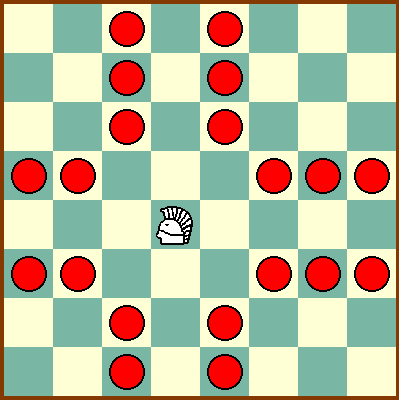Piececlopedia: Cavalier
Historical notes
The Cavalier was invented by Eric Greenwood in 1980 for his game RennChess. The Cavalier has a historical precedent in the somewhat less powerful Griffon from Grande Acedrex.The Duke, also invented by Greenwood for Rennchess, is a related piece with a similar move.
The name Cavalier is also used for a piece that moves like a Mao, but promotes like a Pawn, in Fergus Duniho's Cavalier Chess.
Movement
The Cavalier can move in either of the following ways:
- Step one square diagonally, and then slide any number of squares orthogonally.
- Slide any number of squares orthogonally, then step one square diagonally.
The options given for the Cavalier's movement both produce the same set of destination squares, but give it different paths to those squares.
Movement Diagram
In the diagram below, the Cavalier can move to any of the squares marked with a red circle.

The diagram to the left below illustrates how the Cavalier has two different paths to any destination square. If the Cavalier wishes to move from b1 to a6, he can do so by following either the blue circles or the green circles. As long as one path is open, he can make the journey, even if the other path is blocked.
The diagram on the right illustrates checkmate by Cavalier. Black can not play Bb1 or Bd1 because it would open a path for the Cavalier from f2-b2-a1. If black had a Queen on a2 instead of a Rook, however, he could play Qb1, blocking the Cavalier.


Remarks
The Cavalier is a strong piece. It has the power to pin two pieces at once. Except at close range or in extremely crowded conditions, it is fairly mobile, and does not suffer from the asymmetrical-retreat problems of the Griffon. In the endgame the Cavalier is especially effective at long-range forks. In the diagram below, the Cavalier is attacking eleven enemy pieces at once -- something that neither the standard chess pieces nor the Griffon can do.

The Cavalier's biggest weakness is that it can't move to an adjacent square. For this reason, it is less effective in a crowded opening and middlegame, although it is still less easily blocked than the Mao. It also means that, unlike the Griffon, a Cavalier and King vs. a lone King can not force checkmate. Once the lone King is driven to the edge of the board, the opposing King can not gain opposition without the lone King first threatening capture of the Cavalier. Unlike the Rook, the Cavalier can't slide to safety on the other side of the board without also giving up ground to the lone King.
Currently, I do not know of any games other RennChess that use the Cavalier, but it is a piece worthy of consideration for future games.
This is an item in the Piececlopedia: an overview of different (fairy) chess pieces.
Written by Benjamin C Good.
WWW page created: March 13, 2002.
